Two months ago, I was fortunate to travel to China to run the Ultra-Trail Gobi Race (UTGR), a 400-kilometer (250-mile), self-navigated, non-stop run (unless you sleep while the clock keeps running) through north-central China’s Gobi Desert. I’d never run more than 100 miles in one go nor had I seen the Gobi, so this was going to be an exploration in many senses.
I would have 150 hours to navigate to the 23 checkpoints (which supplied ambient-temperature water only) and 10 rest stations (offering ambient and hot water, heated communal tents, and our drop bags). There were no crews or pacers at the race. Only the checkpoints, rest stations, and the 10 drop bags we could pre-pack for ourselves. Long story short, I made it to the finish in a hair under 99 hours.
What follows are my thoughts on the logistical aspects of the race — the gear, nutrition, hydration, and sleeping — that I relied upon to get me to the finish. This one is for the gear geeks, the experimenters, the curious. Check back next week when I share the narrative of my incredible journey around the Gobi!
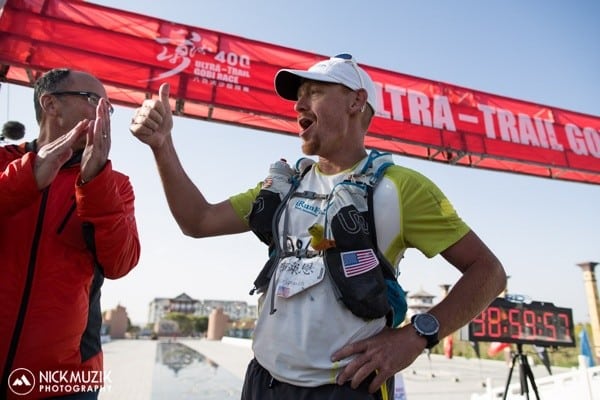
My gear and I at the finish of the 2015 Ultra-Trail Gobi Race. Photo: Nick Muzik
On Gear
So, with a 250-mile outing there’s going to be some gear. As plenty of people asked, I’ll share what I used, why I chose it, and if I’d use it again … er, recommend it.
Shoes
I packed lots of shoes in my drop bags. In total, I think I had 9 pairs of shoes. (In fairness, I left the U.S. with only three pairs!) I ended up wearing only three of those pairs during the race.
- Montrail Bajada II – I was a long-time fan of the original Bajada fan, but hadn’t run in it much of late and only a little in a previous pair of Bajada IIs. I got this pair at UTMB and subsequently wore them for all my running in Europe to save the shoes I’d packed… and came to reestablish my fondness and familiarity with the Bajada. As I had very little inkling of what the terrain and footing would be on the UTGR route, I thought these all-arounders would be a great first choice that would tackle well both smooth, runnable terrain as well more rugged situations. They performed admirably.
I skipped shoe changes at miles 22 and 40 to stick with the Bajada for all of Day 1. I did add the forefoot portion of Altra StoneGuards to the Bajadas. This day’s run solidified my renewed respect for the Bajada. I can see myself wearing them for many runs this winter and could definitely recommend them for UTGR.
- New Balance MT110D – So, this was a nice surprise from my friends at New Balance. It’s a shoe they developed for Liza Howard to run in at the Marathon des Sables last April. It’s the upper for the MT110W with the waterproofing removed and the gaiter extended a bit higher situated on the 910v2 midsole/outsole platform. Basically, it’s a shoe made explicitly for the conditions I’d be running in. Underfoot the shoes performed well, with plenty of grip. I would have slipped in the StoneGuards as supplementary protection, but the lack of removable insole meant I couldn’t and the ball of my right foot was a bit sore by the end of the day, as I’d skipped shoe changes and wore these for 45 miles.
The uppers worked well, keeping out sand and grit while not chafing my lower leg (a concern I’d had) despite wearing socks lower than the gaiter’s neck. Oddly, late in the day, I found myself wishing these were water-resistant as a number of river crossings made for heavy, wet feet late in the day, but these shoes were designed for keeping sand out. All in all, I’ll certainly wear these for more desert adventures and they’d be useful on some parts of the UTGR course, but there are plenty of parts without the requisite grit/sand to warrant gaiters. They’re an awesome tool to have.

The New Balance MT110D
- New Balance RC 1400v3 – This is my go-to shoe, what can I say. I switched into them for the section with most of the race’s asphalt and refused to ditch them the rest of the race. It’s light, it’s breathable, it “runs” well, and with the forefoot Altra StoneGuards, it offers me more than enough protection. Among the few downsides are the very tapered toebox, which certainly encourages the total blistering of both pinky toes with the left one becoming one of my worst blisters ever. (Actually, the blister peeled away, collected sand, and, then, the underlying flesh badly chafed.)
Traction wasn’t a problem except for maybe a quarter mile of steep scrambling to a mountain pass. From the roads to Hardrock and all the way to 140 miles in the Gobi Desert, these are my shoes. In doing UTGR again, I’d pack a few pairs … fresh shoes are fresh shoes! ;-)
[Durability Note: These held up great. The upper fabric is lightly abraded on the outside of one foot, nothing delaminated from the outsole, and, much to my surprise, the midsole wore incredibly evenly. Previously, I had substantially medially packed out the midsole while wearing one pair of 1400v3s for 100 miles at Hardrock.]
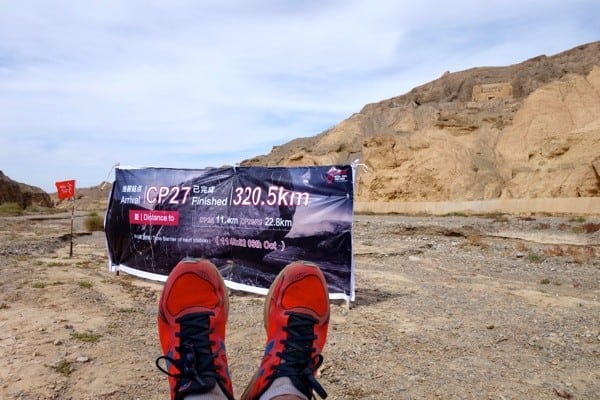
Putting my feet… and my 1400v3s up for a minute in a checkpoint with only 80k to go.
Apparel (Worn)
- Mountain Hardwear Way2Cool Short Sleeve Shirt (original) – I wore one of two of these the entire race. It’s still easily my favorite running shirt of all time. If you’ve got one in medium, I’d buy it from you. Kinda not joking. This shirt fits, drapes, feels, and breathes perfectly. It was hot on Days 1 and 2 and this shirt was great. As a bonus, it still felt good after two-plus days’ use.
- Smartwool PhD Ultra Light Zip T – This long-sleeve, half-zip was great: warm, but not too warm, with micro-adjustments via the half-zip and long sleeves. I’d never done so before, but I think I always wore this over a short sleeve, as I could more easily transition from cool to warm conditions. My small issue with the shirt is that I wish the elastic in the lower arms was more resilient, such that it would fit snugly again after being pushed up my arms. Still, a great shirt I’d wear again.
- New Balance Impact 3-Inch Split Short – I wore one of two pairs of these split shorts throughout the race. They fit me well and I find they move well on me. I’m not 100% sold on the side zip pocket, but I used it and the internal key pocket throughout the race.
- Julbo Race – These have been my go-to running sunglasses for six-and-a-half years now. I may wear a new color, but that’s the only thing that I’ve changed. I’d wear ’em again, no questions. [Note: These are such an a given on my part, that I forgot to include them initially!]
- Mountain Hardwear Ghost Whisperer Hooded Jacket – A simple, lightweight, full-zip jacket. It’s a few years old, but it’s not been bettered by any brand. Aside from being light and compact, it breathes well enough. I rarely run with a hood, but I used the hood on the coldest morning as well as both nights that I was out as well as any other times I got a bit chilly. This would be my jacket again in the future.
- WAA Light Rain Pants – These are about the lightest, most compactable rain pants I’ve ever seen. Pants weren’t part of the required kit, but I sure am glad I had them. A highlight of these pants is the ability to get such a slim-profile pant on over shoes. They also don’t feel as clammy as you’d expect for a rain pant. Notably, the rear of the pants blew out on Night 4 when I bent over. Upon later inspection, there was notable wear with holes in the fabric. With that in mind, if I got a pair in the future, I’d be very careful when and how I used them.
- Drymax Socks: Hot Weather and Max Pro – After wearing Max Pros on Day 1, I wore Hot Weathers the rest of the run. The past few months, after many years of wearing Drymax, I’ve found I prefer the mediums to the larges. My only regret regarding running socks at UTGR is not having medium Hot Weathers in each of my drop bags. There’s not a ton of sand at the race, but foot preservation is key at such a long race, as my feet would have been much better off to change socks every 25 miles.
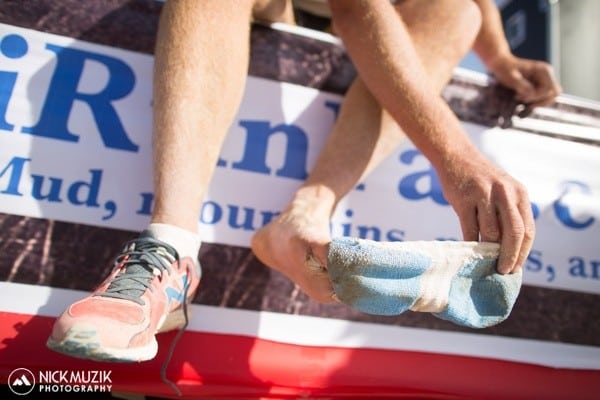
Shedding my Drymax Hot Weather socks after the race. Photo: Nick Muzik
- Mountain Hardwear Nitrous Jacket – I’ve had this down jacket for five-and-a-half years now, and it still performs great. It’s lightweight, but plenty warm. Alas, it’s about time I retire this jacket from wear. [Anyone know of a great down sweater with… and this is key, a chest pocket?]
- The North Face Runners 1 Etip Gloves – These have been my go-to gloves for a year. They’re simply nice running gloves that meet my modest hand-warmth needs under most conditions. The smartphone-compatible fingertips add to the functionality. They’d be in my pack again.
- Mountain Hardwear Raffia Fedora – It’s a women’s fashion hat, but it’s light and breathable, while offering great sun protection and being relatively packable for a 360°-brim. I wore this the first two days until I needed more storage room for warmer clothes on the third morning. I wish I’d had it for more of the race.
- iRunFar Headsweats Race Hat – A great, simple running running hat.
- Bjorne Daelie & Swix Beanies – Both beanies worked well. I used the heavier BD one on the chilly third morning. Otherwise, the lighter Swix beanie was perfect. If I ever needed more, I always had the hood on my Mountain Hardwear jacket.
- Windstopper Mitts – I threw on Windstopper mittens for about 20 minutes when heading out on frigid Morning 3. While unnecessary in the end, I’m glad I’d left the pair at just the spot I did. I’d do it again.
- BUFF Headband – I had this rightly placed in my drop bag where we headed out into a snowstorm on the third morning. I wore it for about as long as I wore the mitts.
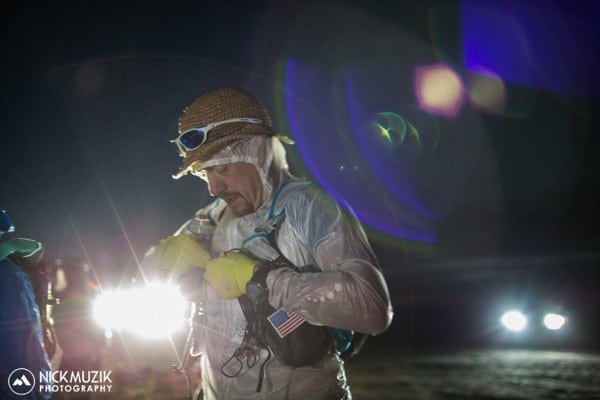
My ridiculous, but functional getup at the start. Photo: Nick Muzik
Apparel (Unworn)
With a snowstorm in progress as we headed out on Morning 3, I brought additional clothes out on the trail. Conditions quickly improved, but it’s worth noting I took the following out on the trail at one point.
- The North Face Thermoball Jacket – I wanted a second jacket in case it was much colder than expected. I wanted that jacket to be synthetic to complement my primary down jacket.
- Mizuno Tights – I had an ancient pair of Mizuno tights for additional lower-body warmth. I never needed these.
Then there were items I packed but never wore.
- Mountain Hardwear Way2Cool Short Sleeve Shirt (original) – I had a third one that I didn’t change into.
- Patagonia Long Haul Western Shirt – I kept rolling with my W2C shirts when I came to this option in a late-race drop bag.
- Swix Midweight Half-Zip – I didn’t need the additional warmth when I got to the drop bag with this shirt.
Gear Gear
- Ultimate Direction Peter Bakwin Adventure Vest 3 (due in January 2016) – I’d worn this specific pack all of twice for a couple of hours total before UTGR, but I’ve so come to trust Ultimate Direction’s current pack lineup that I wasn’t worried about the fit and, in the end, I had no need to be. The pack never chafed me and rode quite well. I probably could have made some adjustments to make it even more comfortable (it rode a bit heavy on one side due to a water bottle), but I got by as it was.
If the side adjustments were a bit easier to get to, I would have done so on the fly. With plenty of front pockets, I was always able to get to the gear I needed minute-by-minute, and both the pair of rear stash pockets and zip cord made for easy apparel stowage and retrieval. So… on the downside, while repacking gear 109 miles into the run, a foot-long section of ripstop nylon blew out on top of the pack (it was an early salesman sample) between the rear yoke and the upper-most (inner-most?) zipper.
This is obviously a critical structural point of the pack. But for finding two zip ties and some quick MacGyvering, I would have been frontpacking my gear for the rest of the run. I made the size of this pack work, but I’d strongly consider a pack with 3-5 additional liters of capacity.
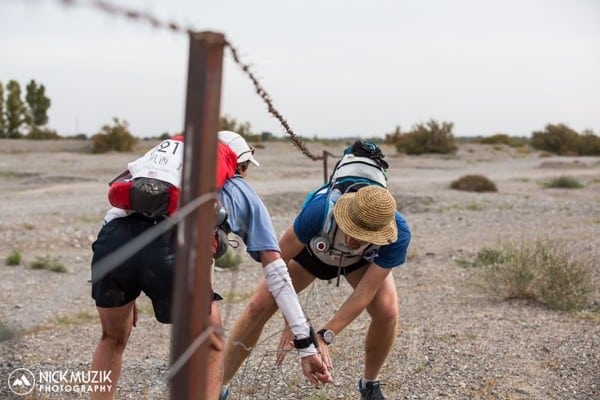
The Ultimate Direction Peter Bakwin v3 hugged my body the entire race. Photo: Nick Muzik
- Montbell Down Hugger #3 – I’ve had this sleeping bag for 7 years and it’s still 100% serviceable. I only used it in the designated rest station in large walled tents with heaters. The bag did great, but I’d keep my eyes open for a lighter 0°C bag.

The Montbell bag was plenty warm in the heated tents on even the coldest night. Photo: Nick Muzik
- Petzl NAO – This light is awesome. I didn’t use reactive mode, but loved being able to pre-set the expected burn time at various brightness levels. The most recent generation of battery packs also proved stellar. The only downside is we needed to carry a spare battery and the combo of the light and two batteries isn’t the lightest. While I’d presumably use the NAO again at UTGR, I’d be open to a disposable lithium battery setup.
- iPhone 5 – This was my GPS (and Google Maps repository) as well as my podcast and music player. I used the ViewRanger app for GPS functionality. While I’ve not previously used the app, it was easy enough to figure out. If I’d not have washed my phone three weeks prior in Norway, this would have been my camera, too, but there was still lens condensation. (Loved my Skullcandy headphones … although I lost both ear gels within a 5-mile span on the fourth evening after a summer of use.)
- Sony RX100II – What an exceptional compact camera. I ran with this for 250 miles and don’t regret it for a minute.
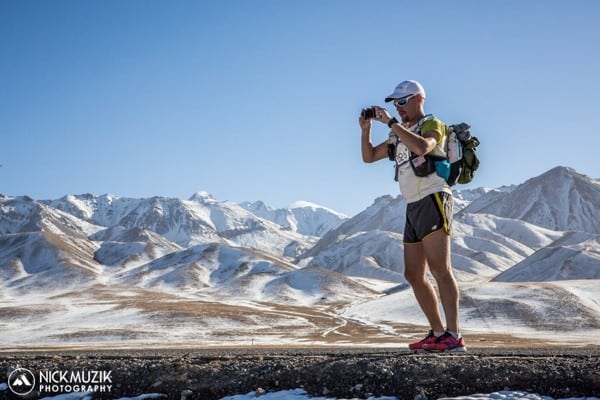
Snapping pics near the course’s high point. Photo: Nick Muzik
- Tonbux 20,000 mAh External Battery (x2) – I picked these up in Spain as I learned that you can fly with no more than two 10,000 mAh external batteries on Chinese domestic flights and I wanted the maximum available capacity to ensure my phone/GPS never died. In the end, they had charging stations at the 10 Rest Areas, so I charged my phone at every stop. I did end up using the battery pack once or twice on the course.
Next time, I’d carry no more than 5,000 mAh at a time. Ideally, I’d find a way to mail two additional batteries to the pre-race hotel in Dunhuang, Gansu Province and have something like 4 x 3,000 mAh batteries spread along the route. I’m good at conserving batteries, but some reassurance is worth the weight.
- Suunto Ambit 3 Peak – I turned down the sampling rate as well as the GPS accuracy along with turning off the heart-rate monitor to maximize battery life and storage capacity. Prior to the race, I experimentally confirmed that the Ambit 3 can be charged while in use, so I charged it at most of the 10 Rest Areas. I also paused recording each of the three times I attempted to sleep, primarily to eliminate the tracking of false mileage from small GPS variations over many stationary hours.
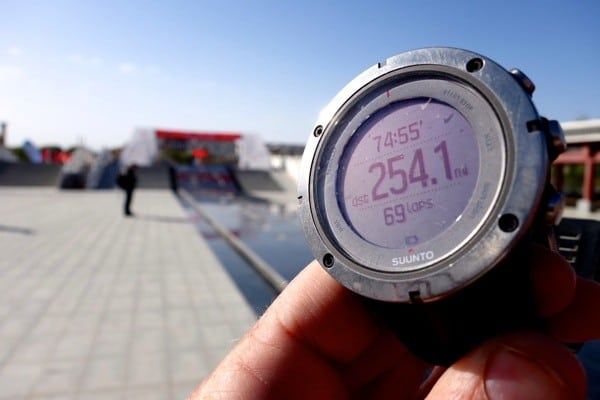
My Suunto Ambit 3 Peak at the finish.
- Ultimate Direction 20-oz Bottle with Kicker Valve, 5L Hydrapak Bladder, and Crushed Disposable Water Bottle – I love the UD Kicker Valve bottle and used it and it alone through the race. We needed 2.5L of capacity, so I carried a 1.5L bladder and when the math showed I didn’t have the required capacity, I crushed an empty disposable water bottle and shoved it in my pack. Next time, I’d use the UD bottle again along with the lightest 2.0L bladder I could find.
- Compass – I’d not used a compass since I was a Cub Scout and I’ll be damned if I remembered anything from 25 years ago. Still, great necessity (i.e., being disoriented amidst 40-foot-tall sand dunes at night) greatly accelerates the learning process and I can now use a compass in full stride.
Gear I Didn’t Use
- Black Diamond Ultra Distance Z-Poles – I had these packed for midrace or just before and had no need for them at the time or in the foreseeable future. Although I now don’t think the course itself generally warrants trekking poles, I think I would still stash a set somewhere further down the course.
- Black Diamond Ion – We were required to have a second headlamp with spare batteries. I didn’t notice this requirement until I was in Europe directly preceding my travel to China. If I could have found a Petzl E-Lite, I would have carried that instead. I have no fear of my primary headlamp malfunctioning.
Other Mandatory Kit
The race has expressed a willingness to adapt its requirements moving forward. In my opinion, one or two of the following mandatory items could be cut.
- Safety Blanket – Sometimes this is a relevant piece of safety equipment, but with the requirement to carry a 0°C sleeping bag, a puffy jacket, a light jacket, as well as a warm hat and gloves, this seems unnecessary. Not a huge issue though.
- Signal Mirror – Redundant to required safety blanket, as I’d guess no more than 10% of trail runners (myself included) know how to properly use a signal mirror… and a large sheet of mylar is likely effective enough for a layperson.
- Blinkie Light – The organizers provided a blinkie light … that we weren’t required to use. If this is for safety use, we already have two headlamps for nighttime signaling as well as at least two means (we also needed a phone) of daytime signaling. I’m all for safety, but there’s a bit more than prudent redundancy requirements here.
On Fueling
As we couldn’t pick up any food at the aid stations (there were one or two places where one could buy food along the course), I decided to do a pre- and post-race survey of my food as it would be a unique opportunity to get a darn-good look at what I ate during the race. While I include a full chart below, here are the highlights.
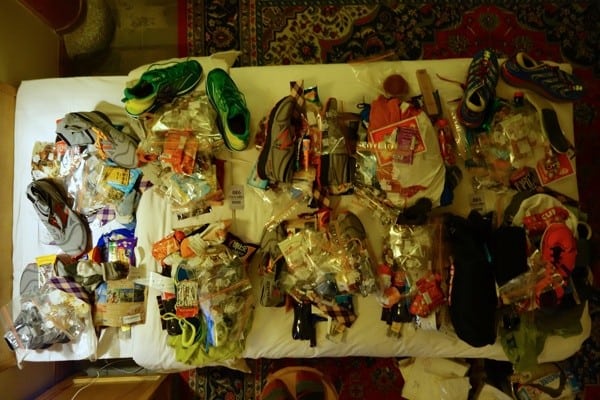
Packing the drop bags.
- I did really well with eating a dehydrated camping meal at 8 of the 10 rest areas. I missed one where I accidentally put a meal from one rest station as a second meal at another and, then, I skipped a meal at the final rest station as my energy was great and I just wanted to be at the finish.
- I heart Coke. I had packed a 600 mL bottle for each rest station and drank 9 of the 10. I don’t know where I missed one. Maybe the final station.
- I just can’t get enough Untapped! Somehow I had 11 left over after Hardrock. I brought all 11 to UTGR and ate 10 of them. I must have missed the other as I would have eaten it.
- I was able to drink Skratch Exercise Hydration Mix throughout the race, nearly 20 packets and I didn’t even have my favorite flavor (lemon).
- Stroopwafel are awesome. I didn’t eat them consistently through the race, but I did get 10% of my overall calories from stroopwafel, mostly by shoving them in my pie … err, wafelhole in aid stations.
- Then again, I ate even more energy chews than stroopwafel, with Honey Stinger Organic Energy Chews and Skratch Fruit Drops coming out on top.
- Wafer cookies. Nomnomnom. I remember packing wafer cookies for some races a decade ago, but it’s been a long time. Pre-race in Dunhuang, I picked up one package for each drop bag and ate 6 of the 10. I’ll remember this for the future.
- Callier Swiss chocolate … there’s never a bad time to eat it!
- I ate a surprising number of almonds at rest stations.
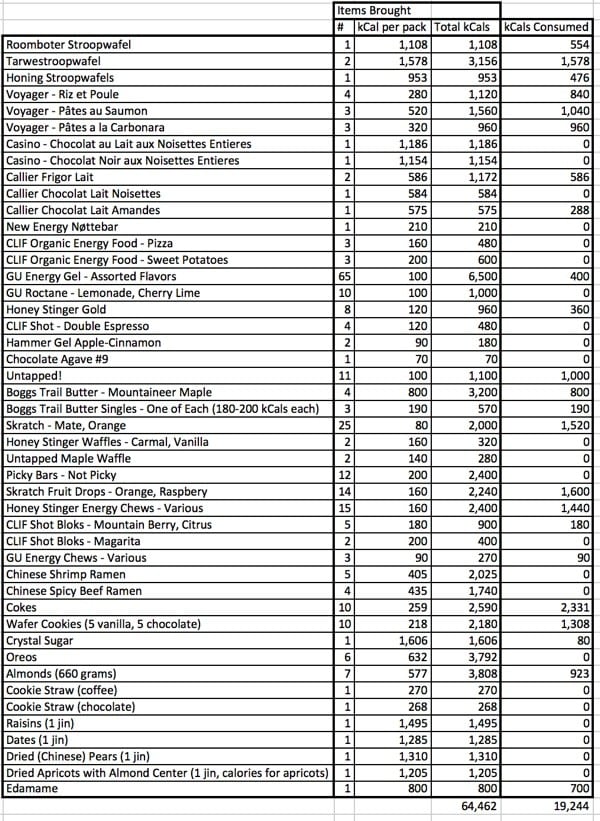
My full-packed supply of food for the 2015 UTGR and what I actually ate.
On Hydration
So, over the past five or six years, I’ve gradually come to drink a great deal less and have stopped supplementing with electrolyte tablets while running. My successful self-maintenance at UTGR feels like a final stamp of approval on this personal evolution. It’s not one that I would extol for others or to which I would encourage a speedy transition. Instead, in this experiment of one, it’s a simple, repeatable, recipe for success.
No matter how long the gap between checkpoints (generally every 10km, but from 5 to 15 km apart), I never carried more than 20 ounces of fluid. During the hotter days, I would guzzle an additional half liter of water at each checkpoint. In addition, I drank nine 600 mL Cokes and ate eight camping meals to which I added more than the required water (by accident). Other than that, I maybe had an additional 10-20 ounces of water in total with tea at the rest stations where I slept.
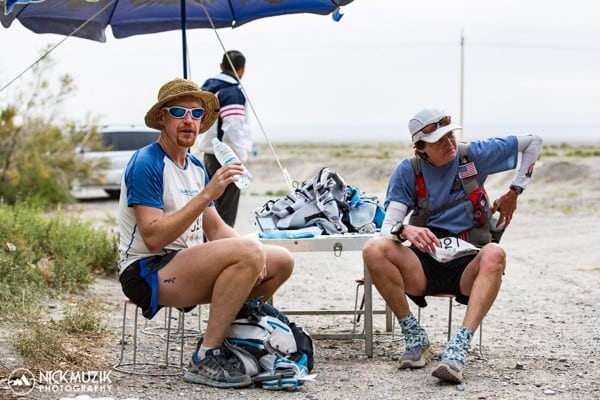
Drinking extra water at the first checkpoint. Photo: Nick Muzik
I did not take any supplementary electrolyte tablets during the four-plus days of the run. I did, however, consume 19 packets of Skratch drink mix and eight relatively small camping meals as well as gels and chews with at least some electrolytes.
In thinking of both hydration and electrolyte maintenance, it’s worth remembering that the first two afternoons the temperatures hit 90°F. It was probably around 80°F on the fourth afternoon, but I never checked. As this was the Gobi Desert, the air was always quite dry and this was likely magnified during our considerable time over 9,000 feet.
Not once did I feel the slightest hint of cramping in my legs or feet. Starting in the middle of Day 3, I had a few minor episodes of my abs slightly cramping, but I attribute that to the fatigue of sitting on camp stools or the ground in an unfamiliar manner where I had to support myself with the muscle at issue. In other words, that muscle was clearly underprepared and, regardless, it was never a real issue.
[Too Much Information Warning] On the hydration side, my urine was never darker than canary yellow and I peed frequently during the race. If anything, there were still times when I felt like I was overhydrating by a small amount, but was willing to keep a small cushion on that side of stasis given the length of the race and the risk of having a period when I couldn’t/didn’t want to drink or faced a dehydrating issue like diarrhea (which I didn’t).
On Sleep
So, most of the folks I’ve talked to who’ve run two-plus-day races speak prominently about the sleep monsters. Their battles with sleepiness were unrelenting and often losing ventures. Such battles punctuate race reports. I’m happy to say that not once during UTGR was I the slightest bit sleepy except when I laid down to sleep. That wasn’t accidental.
The following numbers might not be 100% correct as they’re from memory (recorded less than a week after the race), but they’re close enough to paint the broad picture. We awoke on race morning at 5:45 for a 6:48 a.m. start. I made it to the third rest point around 10 p.m. and got 7-plus hours of sleep. Day 2 was very similar to Day 1, with perhaps an hour later wakeup and start. Once again on night two, I got 7-plus hours of sleep. I had no intention of battling sleep monsters and good nights’ sleep were my plan for warding them off.
I planned to start Day 3 around 8 a.m., but bad weather and then a race-imposed weather hold kept me in camp until 10. I made it two rest points down the course by mid-evening, but decided to push on one more rest point as I wasn’t sleepy. That put me to the next rest point after sunup. I laid down to sleep around 7:45 a.m. with my alarm set for 1 p.m., but I was up around 9, as it was too hot in the tent and I hadn’t really slept anyway. It’s generous to say I got an hour of sleep on “Night 3.” I came to the final rest point in the early morning hours (2 a.m.?). I considered sleeping, but wasn’t at all sleepy and, in the end, just wanted to wrap the whole thing up.
All in all, I likely slept ~16 hours in the 99 hours I was on the course with about an hour of sleep during the final 140 miles.
What I Would Do Differently
I have no idea if I’ll ever run the Ultra-Trail Gobi Race again. (Okay, the preceding was written within a week of the race and, now, as I complete this write-up more than a month later, I really hope to run the race again sometime!) It’s a long journey in all regards, but a rewarding one on so many levels, as well. With that in mind, here are a few notes to myself in case I ever make it back or to anyone considering a similar journey.
- Sleep less. I’ve learned I can easily survive UTGR on two good nights of sleep… and on two-plus days with more or less no sleep. I’d be highly tempted to simply start and keep going until I really needed to sleep at which point I’d grab a couple hours the next time it was dark and I was at a rest station. I spent more than 24 hours—one full day—in the three rest stations where I tried to sleep.
- Train more. I ran 175 miles total in the 11 weeks between running the Hardrock 100 and starting UTGR. That’s less than 16 miles per week over almost an entire season. I had one run of more than 9 miles during that span, a 12 miler with lots of walking and scrambling. Even before Hardrock, months of my training had been mountain hiking focused while UTGR is undoubtedly a running race. A few months of 50-70 miles per week would be a huge help, as would a moderately long, continuous run (20-25 miles) most weeks during that span.
- Rehab calves. I was great about rehabbing my chronically tight and weak-through-avoidance calves before Hardrock. Not so much afterward. Because of that, I was extremely cautious in choosing to walk as opposed to running on even the slightest inclines at UTGR. A few months of somewhat consistent strengthening and stretching would have me running a significant portion of the course that I walked (quickly) this time.
- Train with a pack. My pack was comfortable and never bothered my core. However, I almost never run with a pack and when I do so, I do so with the minimal amount of weight, so my stride was definitely altered throughout UTGR. The altered stride itself was fine, but it’d be great to have another stride length/gear so I could switch around muscle groups a bit more. It’d also be nice to have figured out where I’d store various items, especially in the front of the pack.
- Lighten the load. There’s not much I can do to lighten the mandatory gear although I can shave a few grams (okay, on second thought, a few ounces), but I would still like to cut a pound off the 10-pound dry weight of the pack. Next time, I’d leave my separate camera and Inchey (the inchworm stuffed animal) behind and take a smaller-capacity external battery for my phone (GPS/music player/camera/etc) along with shaving grams from this or that piece of required gear.
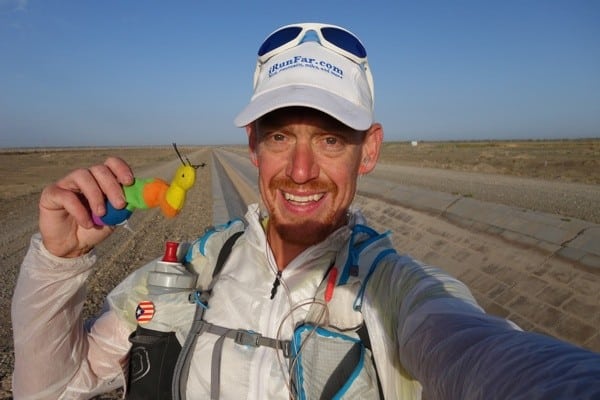
Inchey is believed to be the first inchworm to cover 400 kilometers in one push. He’s one and done at UTGR.
- Lighten me. I started Hardrock at around 150 pounds. I started UTGR at 165 pounds. Starting UTGR 10 pounds lighter would have made things, well, a lot easier!
- Pack less food. With a first go at any new level or type of adventure, I overpack to give myself options. This year, that was the case at Hardrock and again at UTGR. Now, I know what I’m likely (and not so likely) to eat the next go around.
- Protect the feet. Feck, my feet hurt at UTGR! While 250 miles is likely to take its toll on any feet, I could have been more proactive. First, I’d wash my feet more often, possibly at every checkpoint. Second, I’d change socks at possibly every rest point, as even my still-dry socks tended to get grimy and, later, the combo of blister juice and grit turned socks into sandpaper. Third, even if I planned to wear one model shoe, I’d bring multiple pairs along with half-sized-up pairs for later in the race. Finally, I’d bring athletic tape to bandage my feet as needed … I would have brought it this time, but simply couldn’t find what I wanted in China.
- Study more. I did spend a decent amount of time perusing the course on Google Earth. I’d spend even more time on it before running the race again. The studying I did was incredibly useful in identifying some alternative (to the recommended route) routes, which I used, and in having a general sense of the course. Before next time, I have maybe half a dozen places where I’d want to pre-identify and map out my own route. Some are merely finding an obvious route from a canyon floor to a rest station less than a kilometer away. In other places, I’d try to find an alternate route from one checkpoint to where I encountered the most heinous terrain, even if that meant a significantly longer route.
Call for Comments
- If you’ve run a 200-mile or longer race or outing, what would you do differently the next time around?
- Have any questions about my gear or my logistics? Ask away!
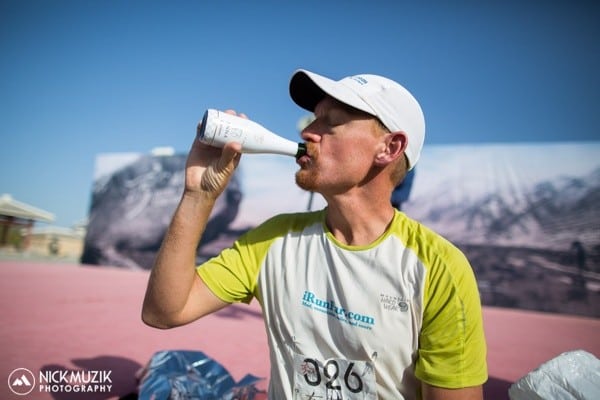
Rehydrating at the finish. Photo: Nick Muzik
